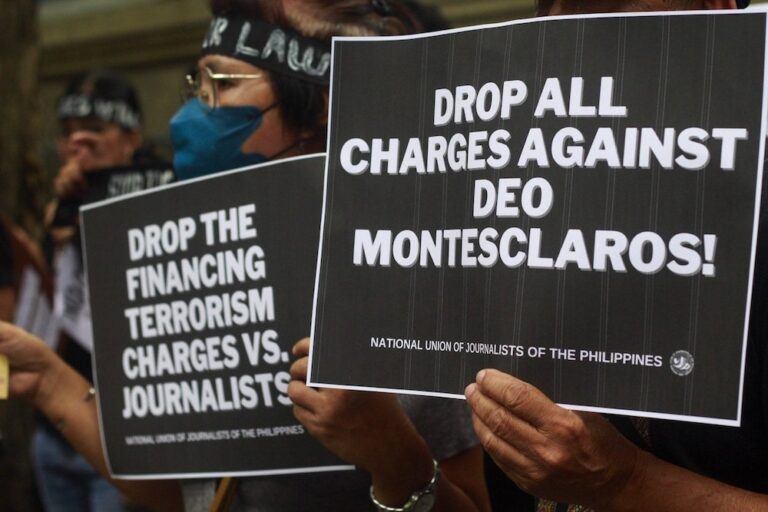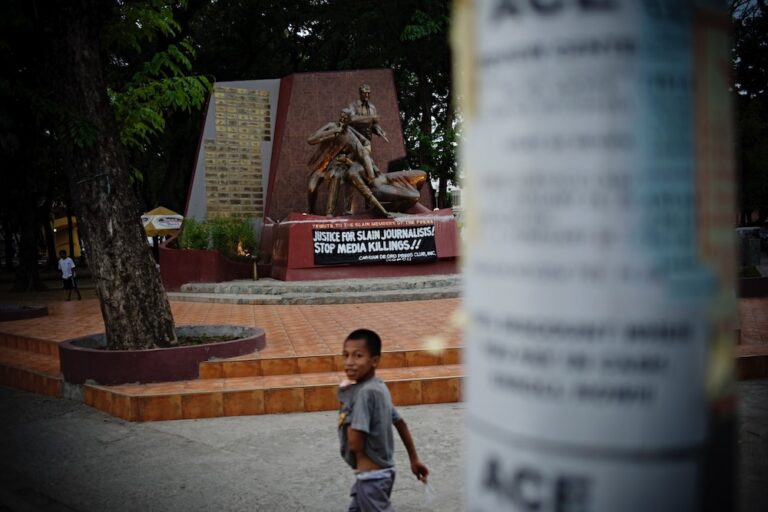Court Administrator Marquez said it was the first time the Supreme Court had granted a media request for live coverage of a court trial.
(CMFR/IFEX) – The Philippine Supreme Court has partially granted the request of media and private complainants to allow live coverage of the trial of 196 persons including members of the Ampatuan clan for the 23 November 2009 murder of 58 persons, among whom 32 were journalists and media workers.
In a resolution penned by Justice Conchita Carpio Morales and promulgated 14 June 2011, the Supreme Court, sitting en banc, allowed pro hac vice (“for this occasion”) live radio and television coverage of the Ampatuan (Maguindanao) Massacre trial, subject to specified guidelines.
“[I]t is about time to craft a win-win situation that shall not compromise rights in the criminal administration of justice, sacrifice press freedom and allied rights, and interfere with the integrity, dignity and solemnity of judicial proceedings,” the resolution read. It explained that the guidelines, which are “not a curtailment of a right, provide a workable solution to the concerns raised in these administrative matters, while, at the same time, maintaining the same underlying principles upheld in the two previous cases.”
The guidelines include the filing of applications for live broadcast; the continuous broadcast of a day’s proceedings with no commercial breaks allowed; and no re-airing of the audio-visual recording made during the proceedings until after the promulgation of the decision.
First time
In ABS-CBN News Channel’s morning show “Headstart” on 15 June, Court Administrator Jose Midas Marquez said it was the first time the Supreme Court had granted a media request for live coverage of a court trial. The Supreme Court had previously denied two requests for live coverage filed by members of the Philippine media.
The 14 June resolution said: “One apparent circumstance that sets the Maguindanao Massacre cases apart from the earlier cases is the impossibility of accommodating even those party to the cases — the private complainants/families of the victims and other witnesses — inside the courtroom.”
The first request came in 1991 when a local court heard the libel charges filed by former president Corazon Aquino against then “Philippine Star” columnist Luis Beltran after the latter said in his column that the former president “hid under her bed” when rebel soldiers attacked Malacañang during a 1987 coup d’etat attempt.
In 2001, the media again requested live coverage of court proceedings under the supervision of the Sandiganbayan (Ombudsman court) of the plunder cases filed against former president Joseph Estrada. The Court initially denied this request, but later allowed the press to cover the promulgation of the decision live.
Restrictive?
While the petitioners recognised the decision as a positive development, some media organisations claimed that the guidelines were unduly “restrictive”.
In a report published online by Interaksyon.com on 16 June 2011, Romeo Capulong, a human rights lawyer who was part of the team that prepared the petition requesting live coverage, emphasized that the press needs to be “creative and to ensure that the guidelines do not stifle the effective delivery of news about the trial, or impinge on editorial judgment”.
The National Union of Journalists of the Philippines (NUJP), the national broadcast networks ABS-CBN Broadcasting Corp, TV5, and GMA-7, individual journalists and media workers, and relatives of the massacre victims (private complainants in the murder cases) filed before the Supreme Court the “petition to allow radio and television coverage” on 19 November 2010. They asked the Court to: (1) “abandon” its resolutions on the requests for live coverage of the libel case against Beltran and the plunder case against Estrada, (2) allow live radio and television coverage of the Ampatuan Massacre trial, (3) allow recording devices inside the courtroom, and (4) “formulate reasonable guidelines that will govern the conduct of television coverage of the Ampatuan trial and of other trials in the future.” (Disclosure: The Deputy Director and editorial staff of the Center for Media Freedom and Responsibility signed the petition.)
President Benigno Aquino III also wrote to Supreme Court Chief Justice Renato Corona saying he supports the request for live coverage. His letter-request was consolidated with the NUJP-led petition.
The National Press Club and the Alyansang Filipinong Mamamahayag also filed a separate petition which asked for “the setting up of a videocam and monitor just outside the court for journalists to cover and for the people to witness the ‘trial of the decade’ to make it truly public and impartial as commanded by the Constitution.”
The petitioners will meet the Supreme Court Administrator for further clarification of the guidelines.
The worst attack against the press in Philippine history, the 23 November 2009 massacre in Ampatuan town in Maguindanao province left 58 individuals, including 32 journalists and media workers dead. The trial of 196 individuals including principal accused Andal “Unsay” Ampatuan, his father and former Maguindanao governor Andal Ampatuan Sr., and brother, former Autonomous Region in Muslim Mindanao governor Zaldy Ampatuan, is ongoing.


